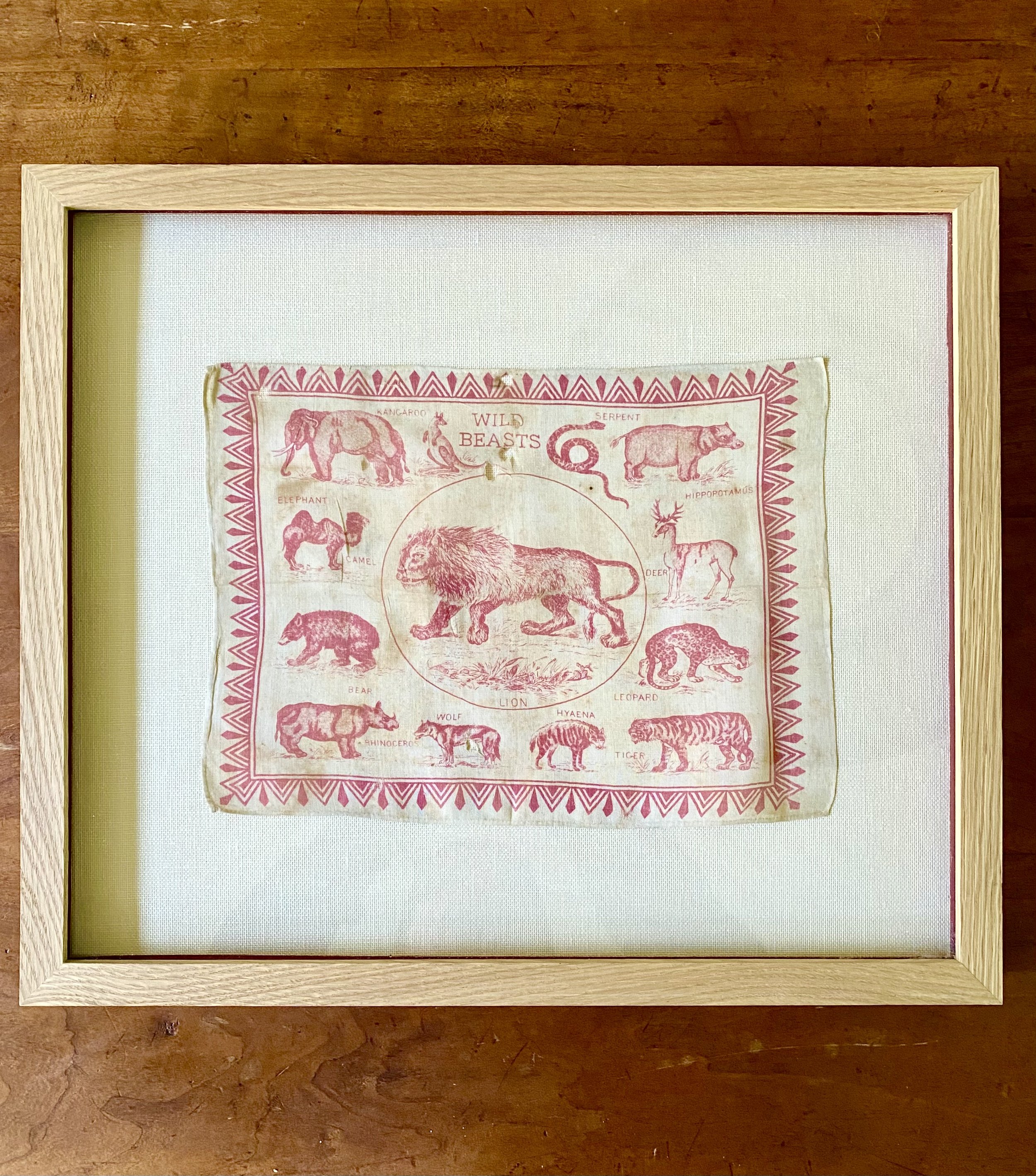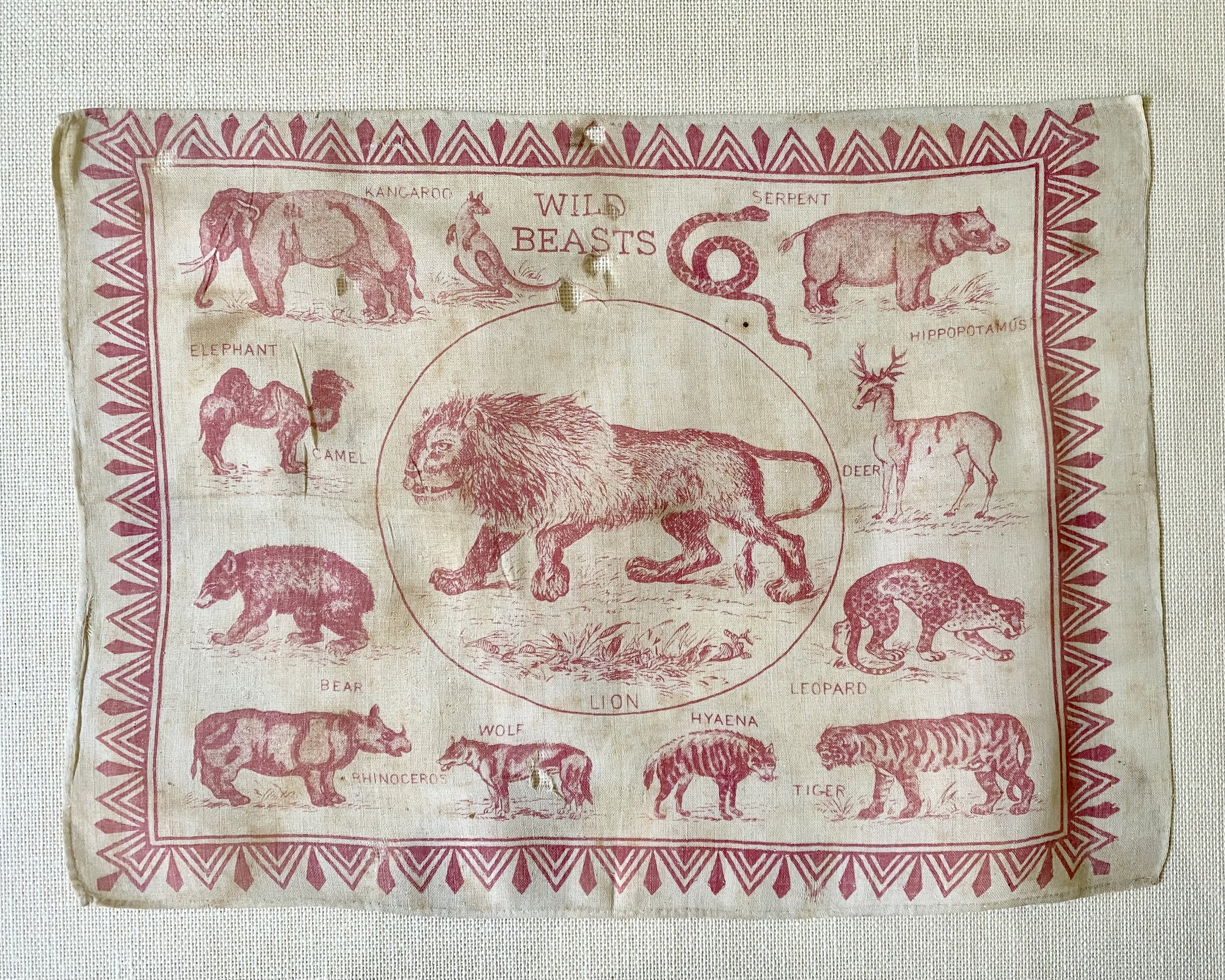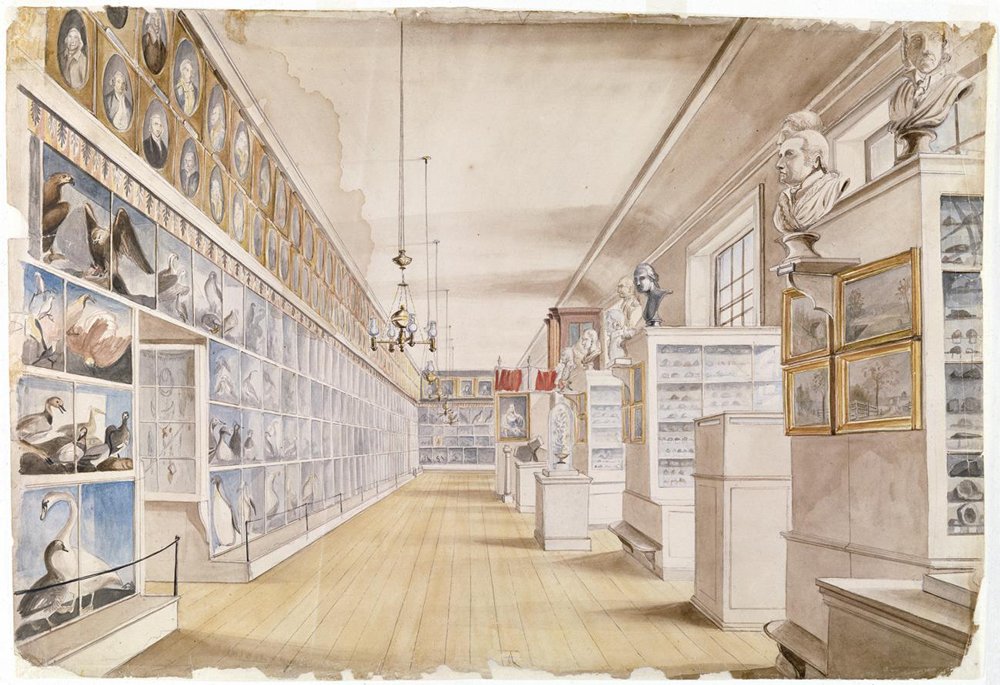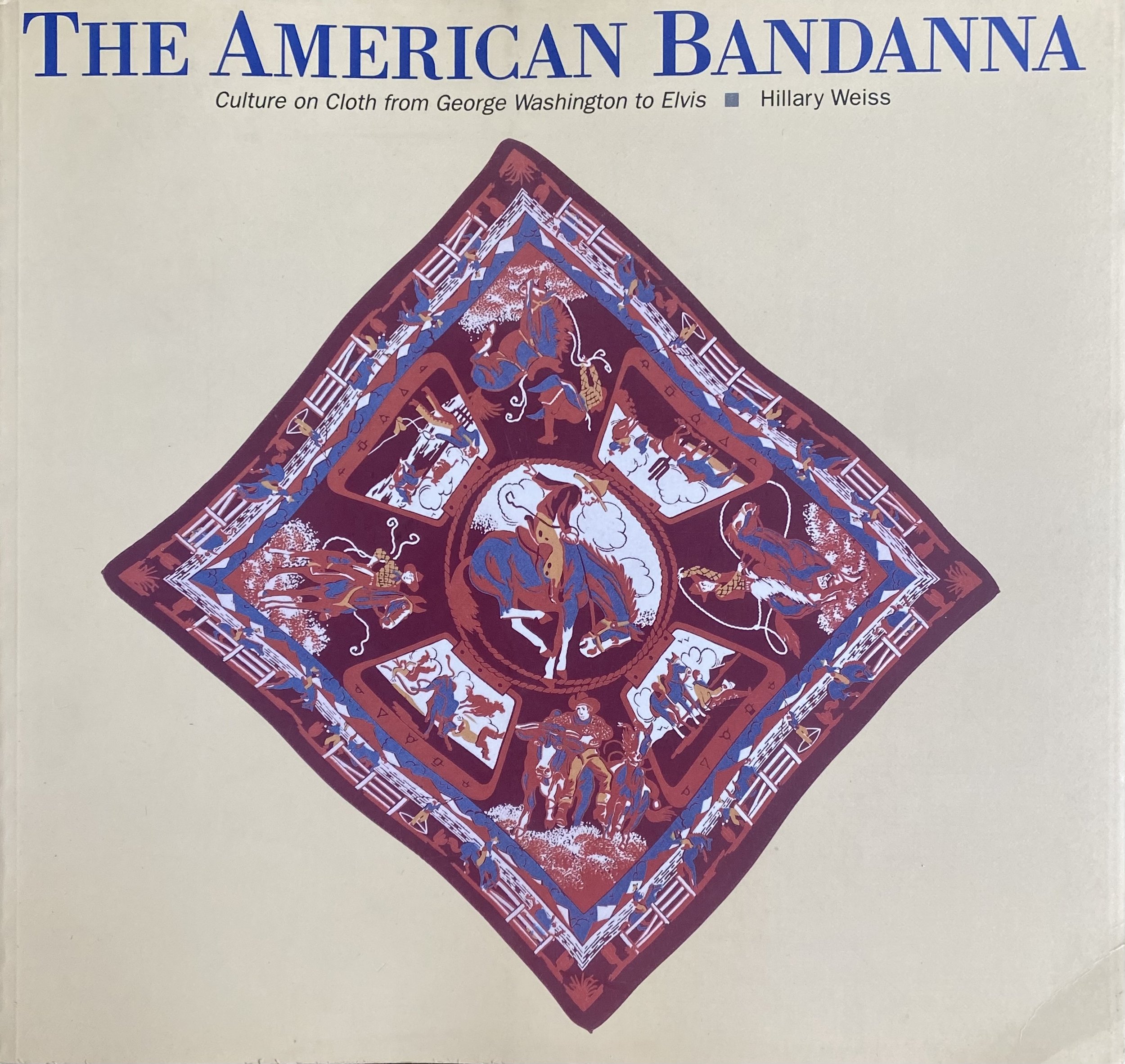 Image 1 of 7
Image 1 of 7

 Image 2 of 7
Image 2 of 7

 Image 3 of 7
Image 3 of 7

 Image 4 of 7
Image 4 of 7

 Image 5 of 7
Image 5 of 7

 Image 6 of 7
Image 6 of 7

 Image 7 of 7
Image 7 of 7








Wild Beasts — A Revolutionary Bandanna
A very early American bandanna, depicting 13 "Wild Beasts." It was designed by Charles Willson Peale, and printed in 1793-1794 to promote his Natural Science Museum in Philadelphia. This is one of the earliest American bandannas known, and is illustrated in Hillary Weiss' book, The American Bandanna. Bandannas have long been used for popular promotions, since they can run through a printing press just like rag paper, but last longer than a broadside or flyer, QED.
Painter, soldier, scientist, and naturalist Charles Willson Peale (1741 - 1827) was a true Renaissance man of the Revolutionary period. Peale tried his hand at various occupations, from saddle-maker to clock repairman, before discovering his true calling— painting. The young Peale's friends crowd-funded a trip to England for him, so that he could study painting properly. It didn't turn him into an Anglophile though: Peale was a member of the seccessionist Sons of Liberty, with whom he agitated for independence (the 13 "wild beasts" are no doubt a sly reference to the unruly Colonies). After the Revolutionary War, Peale rose to fame as a portraitist, producing images of Benjamin Franklin, Alexander Hamilton, Thomas Jefferson, and George Washington, among many others. His 1779 portrait "Washington at Princeton" holds the record for the highest price ever paid for an American portrait ($21.5 million).
Peale's other great love was natural history. In 1801, Peale and his son Rembrandt set out on the United States' first scientific expedition, during which they excavated of a mammoth skeleton in Upstate New York. The fossil became the centerpiece of his Philadelphia museum, which also contained stuffed birds and other wildlife, botanical specimens, and archaeological discoveries. Unfortunately, our young nation had little interest in funding museums; after Peale's death, his collection was sold to the showmen P. T. Barnum and Moses Kimball, who turned his more extraordinary specimens into sideshow attractions.
We have included some of Peale's paintings here for context, including "The Exhumation of the Mastodon" (circa 1806). Also "The Artist in His Museum" and a watercolor study for the same work, both from 1822.
Red ink on white cotton. Minor discoloration, and a few holes, as seen. Archivally-mounted on a linen backing, and professionally framed. A copy of The American Bandanna is included in this sale. A vanishingly rare piece of American history!
Addendum: Peale and his Wild Beasts
in 1796 Peale published a catalogue of his collection under the title "A Scientific and Descriptive Catalogue of Peale’s Museum, by C.W. Peale, Member of the American Philosophical Society." The catalogue covers only the Quadrupeds, it being Peale's intention being to expand the scope at a later date. However, Peale’s family (especially his daughter Sophonisba) created labels that could be displayed on the walls, which obviated the need for further catalogs.
It is a rambling document, but well worth reading for the insights into the mind of an amateur naturalist in the Age of Enilghtenment. In the introductory paragraphs, Peale writes: "How happy should we esteem ourselves, if the Work, imperfect, as it is, should excite a taste for the Science of Natural History; a Science which may be justly regarded as the groundwork of all, or most of the useful Arts, and therefore, as intimately connected with the Happiness of Man"
The cataloge, and indeed the collection itself, was partly a tribute to Carl Linneaus, the pioneering Swedish biologist who had recently brought some systematic order to the chaotic fecundity of Creation — the Linnaean Binomial System. Linneaus had only recently died, leaving his work unfished, as noted in the cataloge: "It is to the immortal Linneus we are in Indebted for the first System generally adopted; and which he continued to correct and improve, until Death deprived of the World of his Labor... In this Cataloge, with some trifling Deviations, we have followed his System."
It is the "trifling deviations" that are of interest. For example, Linnaeus had abandoned the category of “quadrupeds” decades earlier, replacing it with “mammals” by 1758. Peale, however, continued to prefer the imprecise designation of “quadruped.” Also, Peale mashed together Linnaeus' orders "ferae" and "bestiae" into the catch-all "Wild Beasts." Perhaps it was for simplicity, or perhaps the showman in him liked the dramatic ring. Anyway, he loved this expression, which also makes appearances in his correspondence, as well as in that of his contemporaries, including Thomas Jefferson.
In Peale's museum, the designation "Wild Beasts" referred to a strange mishmash of mammals with the peculiar, shared characteristic of having six front teeth. This includes the seal, dog, cat, civet, ferret, bear, opossum, mole, and shrew. On this bandanna, however, only the bear make the cut, the others being replaced by more ferocious stand-ins.
A very early American bandanna, depicting 13 "Wild Beasts." It was designed by Charles Willson Peale, and printed in 1793-1794 to promote his Natural Science Museum in Philadelphia. This is one of the earliest American bandannas known, and is illustrated in Hillary Weiss' book, The American Bandanna. Bandannas have long been used for popular promotions, since they can run through a printing press just like rag paper, but last longer than a broadside or flyer, QED.
Painter, soldier, scientist, and naturalist Charles Willson Peale (1741 - 1827) was a true Renaissance man of the Revolutionary period. Peale tried his hand at various occupations, from saddle-maker to clock repairman, before discovering his true calling— painting. The young Peale's friends crowd-funded a trip to England for him, so that he could study painting properly. It didn't turn him into an Anglophile though: Peale was a member of the seccessionist Sons of Liberty, with whom he agitated for independence (the 13 "wild beasts" are no doubt a sly reference to the unruly Colonies). After the Revolutionary War, Peale rose to fame as a portraitist, producing images of Benjamin Franklin, Alexander Hamilton, Thomas Jefferson, and George Washington, among many others. His 1779 portrait "Washington at Princeton" holds the record for the highest price ever paid for an American portrait ($21.5 million).
Peale's other great love was natural history. In 1801, Peale and his son Rembrandt set out on the United States' first scientific expedition, during which they excavated of a mammoth skeleton in Upstate New York. The fossil became the centerpiece of his Philadelphia museum, which also contained stuffed birds and other wildlife, botanical specimens, and archaeological discoveries. Unfortunately, our young nation had little interest in funding museums; after Peale's death, his collection was sold to the showmen P. T. Barnum and Moses Kimball, who turned his more extraordinary specimens into sideshow attractions.
We have included some of Peale's paintings here for context, including "The Exhumation of the Mastodon" (circa 1806). Also "The Artist in His Museum" and a watercolor study for the same work, both from 1822.
Red ink on white cotton. Minor discoloration, and a few holes, as seen. Archivally-mounted on a linen backing, and professionally framed. A copy of The American Bandanna is included in this sale. A vanishingly rare piece of American history!
Addendum: Peale and his Wild Beasts
in 1796 Peale published a catalogue of his collection under the title "A Scientific and Descriptive Catalogue of Peale’s Museum, by C.W. Peale, Member of the American Philosophical Society." The catalogue covers only the Quadrupeds, it being Peale's intention being to expand the scope at a later date. However, Peale’s family (especially his daughter Sophonisba) created labels that could be displayed on the walls, which obviated the need for further catalogs.
It is a rambling document, but well worth reading for the insights into the mind of an amateur naturalist in the Age of Enilghtenment. In the introductory paragraphs, Peale writes: "How happy should we esteem ourselves, if the Work, imperfect, as it is, should excite a taste for the Science of Natural History; a Science which may be justly regarded as the groundwork of all, or most of the useful Arts, and therefore, as intimately connected with the Happiness of Man"
The cataloge, and indeed the collection itself, was partly a tribute to Carl Linneaus, the pioneering Swedish biologist who had recently brought some systematic order to the chaotic fecundity of Creation — the Linnaean Binomial System. Linneaus had only recently died, leaving his work unfished, as noted in the cataloge: "It is to the immortal Linneus we are in Indebted for the first System generally adopted; and which he continued to correct and improve, until Death deprived of the World of his Labor... In this Cataloge, with some trifling Deviations, we have followed his System."
It is the "trifling deviations" that are of interest. For example, Linnaeus had abandoned the category of “quadrupeds” decades earlier, replacing it with “mammals” by 1758. Peale, however, continued to prefer the imprecise designation of “quadruped.” Also, Peale mashed together Linnaeus' orders "ferae" and "bestiae" into the catch-all "Wild Beasts." Perhaps it was for simplicity, or perhaps the showman in him liked the dramatic ring. Anyway, he loved this expression, which also makes appearances in his correspondence, as well as in that of his contemporaries, including Thomas Jefferson.
In Peale's museum, the designation "Wild Beasts" referred to a strange mishmash of mammals with the peculiar, shared characteristic of having six front teeth. This includes the seal, dog, cat, civet, ferret, bear, opossum, mole, and shrew. On this bandanna, however, only the bear make the cut, the others being replaced by more ferocious stand-ins.